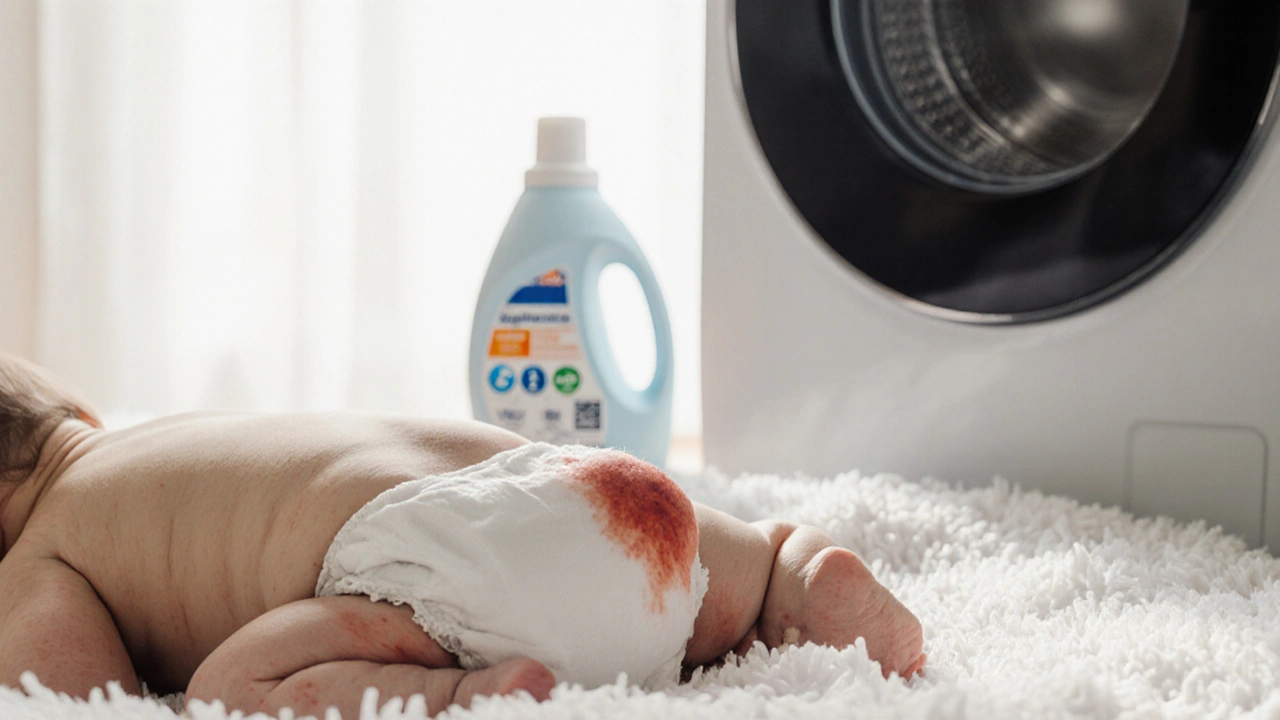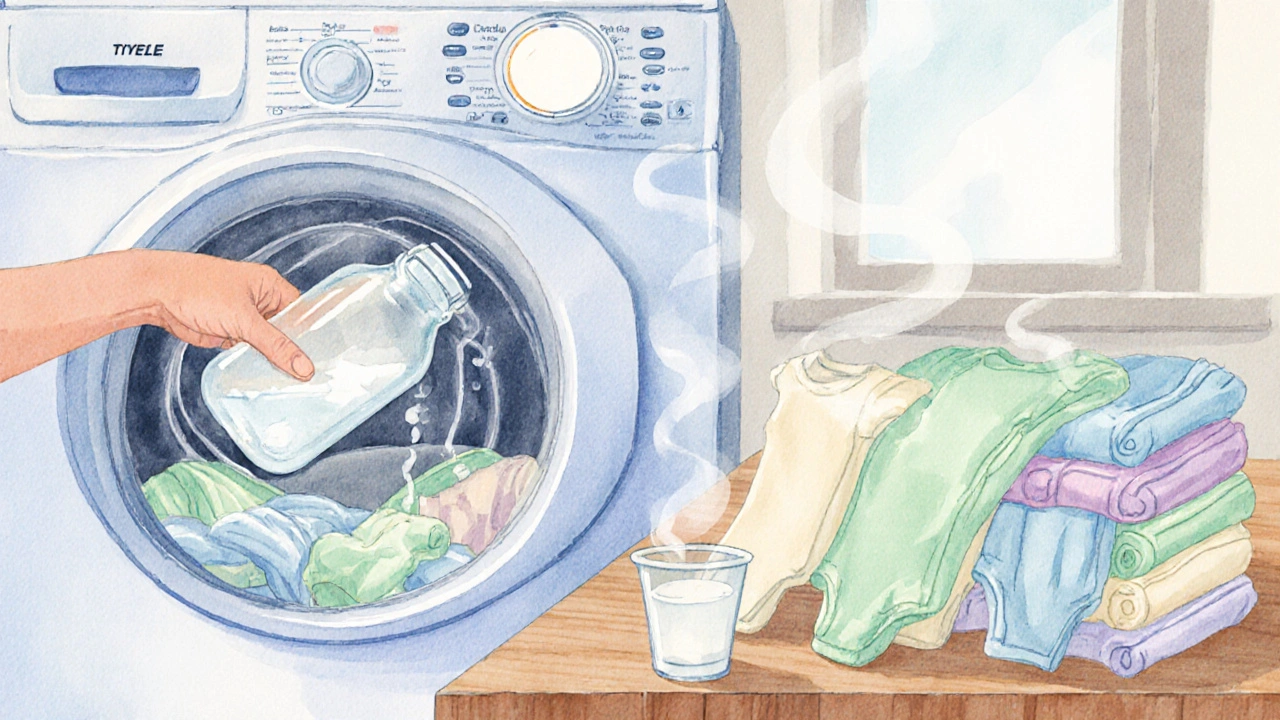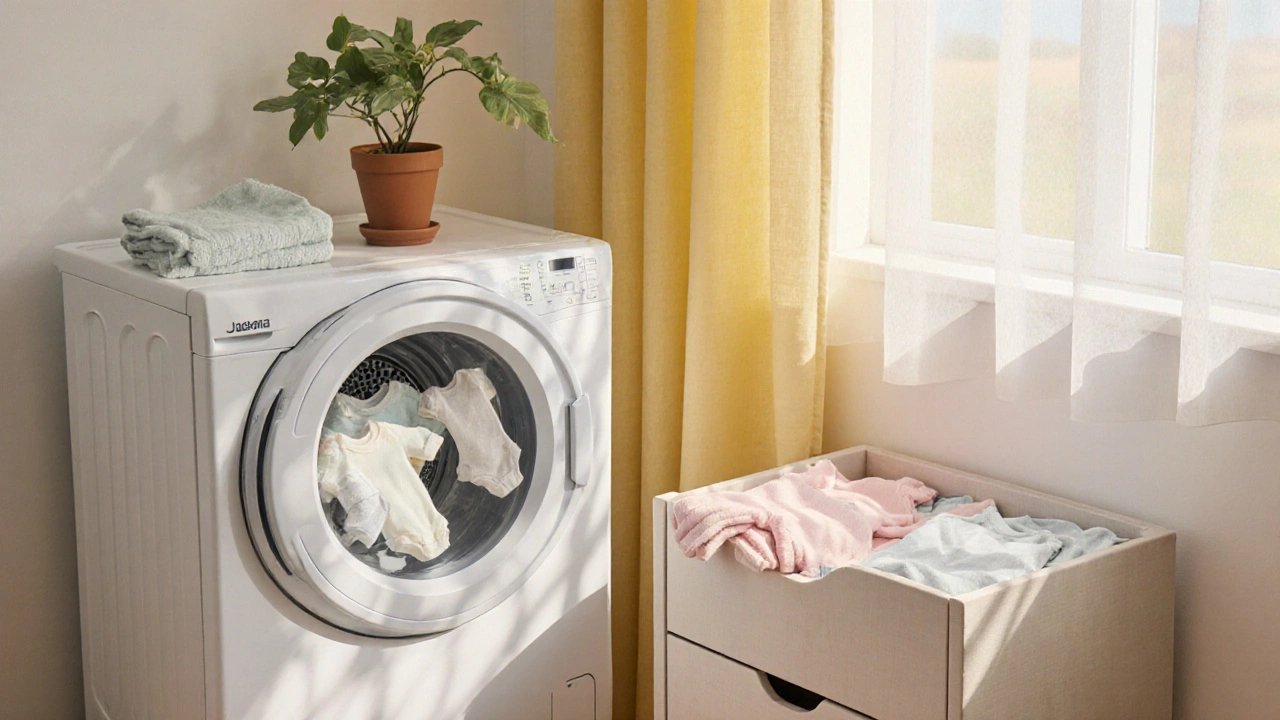
Baby Laundry Ingredient Checker
Select the ingredients in your baby laundry products to see if they could contribute to diaper rash.
Analysis Results
If you’re battling diaper rash and can’t figure out why, the culprit might be hiding in your washing machine. Many parents assume diaper rash is only caused by moisture or a new diaper brand, but the chemicals and residues left on baby clothes can also irritate delicate skin. Below we break down how laundry habits affect a baby’s bottom, what to look for, and practical steps to keep rash at bay.
What Is Diaper Rash?
Diaper rash is a red, inflamed area on a baby’s skin that appears where a diaper sits, often accompanied by soreness or peeling. It’s usually the result of prolonged exposure to moisture, friction, and irritants. While most cases are mild and clear up with simple care, recurring rash signals that something in the environment-like laundry products-is continuously aggravating the skin.
How Laundry Choices Affect Baby Skin
Baby laundry is the routine of washing infant clothing, blankets, and diaper covers, ideally using gentle cycles and skin‑friendly detergents. Every wash leaves a thin film of whatever you’ve used in the tub, and that film can sit against a newborn’s thin epidermis for hours each day. The two biggest laundry factors that raise the risk of rash are the cleaning agents themselves and the temperature of the water.
Detergent is a surfactant blend designed to break down oils, dirt, and stains on fabric. Conventional detergents often contain fragrances, dyes, enzymes, and optical brighteners-ingredients that are perfectly safe for adult skin but can trigger a reaction on a baby’s sensitive barrier.
Fabric softener is a conditioning additive that reduces static and makes fabrics feel smoother. It typically adds more fragrance and chemicals that cling to fibers longer than detergent, increasing the chance of skin contact.
Water temperature is the heat level at which the wash cycle runs, measured in degrees Celsius or Fahrenheit. Hot water can cause certain detergent residues to bond more tightly to cotton, while cold water may leave more particles suspended in the rinse, both leading to buildup.
Common Laundry Culprits
- Fragrances - synthetic scents are top allergens for infants.
- Dyes - especially bright, neon colorants that don’t rinse out completely.
- Enzymes - proteases and lipases that break down protein‑based stains can also strip natural skin oils.
- Optical brighteners - chemicals that reflect UV light to make whites look whiter, but remain on fabric.
- Fabric softener residues - often contain quaternary ammonium compounds, known irritants.

Choosing the Right Detergent
Not all detergents are created equal. When shopping for a baby‑friendly option, look for these key attributes:
| Type | Fragrance | Dyes | Enzyme | Recommended for |
|---|---|---|---|---|
| Standard | Yes | Yes | Yes | Adults, not ideal for infants |
| Fragrance‑Free | No | Yes | Yes | Babies with mild sensitivities |
| Hypoallergenic detergent | No | No | No | Highly sensitive skin, eczema‑prone infants |
| Plant‑Based | Often No | No | Yes (mild) | Parents preferring eco‑friendly formulas |
For most newborns, a hypoallergenic detergent is the safest bet because it eliminates the three biggest irritant categories: fragrance, dyes, and strong enzymes.
Laundry Best‑Practice Checklist
- Run an extra rinse cycle to flush out any lingering soap.
- Use warm, not hot, water (30‑40°C) to avoid setting residues.
- Avoid fabric softeners; instead, add a half‑cup of white vinegar during the final rinse to naturally soften fibers.
- Separate baby items from adult garments to prevent cross‑contamination.
- Dry on low heat or air‑dry; high dryer temperatures can break down fibers, trapping chemicals.
- Store clean baby clothes in a breathable cotton drawer, not plastic bags.
When the Rash Isn’t Laundry‑Related
Even with perfect laundry habits, diaper rash can still appear. Common non‑laundry triggers include:
- Prolonged wetness - change diapers every 2-3hours during the day.
- Friction from tight diapers - choose a size that fits snugly but doesn’t dig.
- New diaper brands - some contain excess alcohol or lotion that may irritate.
- Yeast or bacterial infection - look for a bright red, raised rash with tiny bumps.
- Underlying skin conditions such as eczema or psoriasis.

Quick Treatment Steps for an Outbreak
- Gently cleanse the area with warm water and a soft cloth; avoid wipes with alcohol or fragrance.
- Pat dry - never rub.
- Apply a thin layer of zinc oxide cream; it creates a breathable barrier.
- Give the baby some diaper‑free time each day to let skin air out.
- If the rash persists beyond 48hours or spreads, consult a pediatrician.
Next Steps & Troubleshooting
After you’ve changed your laundry routine, monitor the baby’s skin for a full diaper‑change cycle (about a week). If the rash continues, consider these deeper checks:
- Test for hard water - mineral buildup can interact with detergent residues. A simple water‑hardness test kit costs under $10.
- Switch to a fragrance‑free, dye‑free diaper brand and watch for improvement.
- Inspect the washing machine’s drum for mold or soap scum; run an empty hot cycle with two cups of white vinegar every month.
- Rotate detergents - occasionally using a plant‑based formula can reduce the risk of a single ingredient sensitizing the skin.
Remember, the goal isn’t to overhaul every household habit, just to remove the hidden irritants that most parents never consider. With a few tweaks, you’ll likely see the redness fade and keep those tiny cheeks happy.
Frequently Asked Questions
Can regular laundry detergent cause diaper rash?
Yes. Fragrances, dyes, and enzymes in standard detergents can linger on baby clothes and irritate the skin, especially when the fabric stays in contact with a wet diaper for long periods.
Do I need to avoid fabric softener entirely?
It’s safest to skip fabric softener on anything that will touch a baby’s skin. If you want extra softness, add a half‑cup of white vinegar in the final rinse; it naturally softens without the chemicals.
Is warm water better than cold for baby laundry?
Warm water (30‑40°C) helps dissolve detergent fully, reducing residue. Hot water can set stains and bind chemicals tighter to fibers, while cold water may not rinse them away completely.
How often should I add an extra rinse?
Add an extra rinse on every wash of baby garments. Most modern machines have a “extra rinse” option that takes just a few minutes.
When should I see a doctor for diaper rash?
If the rash lasts longer than 48hours despite proper care, spreads beyond the diaper area, or shows signs of infection (pus, fever, or intense pain), schedule a pediatric appointment.
Comments (14)
-
lee charlie October 6, 2025
I totally get how frustrating diaper rash can be and the laundry angle is something many overlook. The guide breaks it down nicely and gives practical steps that feel doable even on a busy schedule. Adding that extra rinse and switching to a fragrance‑free detergent are low‑effort changes that can make a big difference. Keep an eye on the baby’s skin after each wash and you’ll see improvement soon.
-
Greg DiMedio October 11, 2025
Oh great, another laundry‑science lecture. As if we needed a PhD to pick a detergent. Just toss the fancy label and go cheap, the baby’s skin will thank you for the extra chemicals.
-
Badal Patel October 15, 2025
Esteemed readers,; by virtue of the aforementioned exposition; one might conclude, with a certain degree of scholarly confidence, that the utilization of hypoallergenic detergents, devoid of synthetic fragrances, dyes, and enzymatic agents, constitutes a paramount recommendation; nevertheless, the practical implementation thereof may encounter quotidian impediments, such as budgetary constraints, availability of specialized products, and parental fatigue; consequently, a nuanced approach, balancing idealistic aspirations with realistic considerations, is advisable.
-
KIRAN nadarla October 20, 2025
From an analytical standpoint, the residual surfactant molecules left on cotton fibers act as a microscopic irritant, akin to sandpaper on delicate epidermis. Empirical studies correlate high‑risk ingredients with increased incidence of erythema in infants. Therefore, a systematic extra‑rinse protocol, coupled with the elimination of quaternary ammonium compounds, is not merely advisable but statistically substantiated. Routine maintenance of the washing machine also mitigates cumulative buildup, a factor often overlooked in casual discussions.
-
Kara Guilbert October 25, 2025
It’s just plain wrong to ignore the chemicals you wash onto a baby's skin, especially when those chemicals could be avoided. Parents have a duty to protect the most vulnerable, and using fragrance‑filled detergents is just lazy and selfish.
-
Sonia Michelle October 29, 2025
Think of each wash as a covenant with your child’s comfort. By choosing a detergent that respects the integrity of their skin, you’re honoring that covenant. It’s not a sacrifice; it’s an act of love that aligns with the principle that prevention is kinder than cure. Let’s encourage one another to share trusted brands and recipes, building a community of mindful caregivers.
-
Neil Collette November 3, 2025
Sure, because swapping soap magically turns you into a parenting guru. While you’re busy preaching love, the real issue is that most parents can’t afford niche “covenant‑detergents”. Maybe mention cost‑effective DIY alternatives instead of lofty platitudes.
-
James Lee November 7, 2025
Honestly, this whole laundry discourse feels like an overblown existential crisis about suds. If you’re going to write a whole article, at least make it less fluffy and more straight‑to‑the‑point.
-
Dennis Scholing November 12, 2025
Thank you all for sharing insights. For those seeking a concise checklist: 1) Use fragrance‑free, dye‑free detergent; 2) Add an extra rinse; 3) Skip fabric softener or replace with vinegar; 4) Wash in warm water (30‑40 °C); 5) Dry on low heat. Consistency with these steps has been shown to reduce rash frequency considerably.
-
Kasey Lauren November 17, 2025
Extra rinse is a game‑changer for baby clothes.
-
joshua Dangerfield November 21, 2025
I’ve noticed that even with hypoallergenic detergent, sometimes a lingering smell remains. Could that be from the washing machine itself? Maybe a monthly vinegar cycle helps eliminate hidden residues.
-
Abhimanyu Singh Rathore November 26, 2025
First, let us acknowledge the sheer complexity that modern laundry products introduce into infant dermatology; the average parent is now required to navigate an alphabetical soup of chemical names, each promising gentleness while potentially harboring hidden allergens. Second, the physics of surfactant adhesion tells us that residues are not merely surface‑level but can penetrate the micro‑fibers of cotton, creating a persistent irritant layer. Third, epidemiological data from pediatric clinics reveal a statistically significant correlation between the use of fragrance‑laden detergents and the incidence of diaper rash in the first six months of life. Fourth, the optical brighteners, while visually appealing, are known to remain on fabrics after the rinse cycle, reflecting ultraviolet light and provoking photosensitive reactions in some infants. Fifth, enzymes, though effective at breaking down protein stains, may also strip the natural lipid barrier of newborn skin when residual activity persists. Sixth, the addition of fabric softeners introduces quaternary ammonium compounds, which have been documented to cause contact dermatitis in sensitive populations. Seventh, temperature plays a critical role; warm water facilitates complete solubilization of detergent, whereas hot water may cause certain molecules to polymerize onto fibers. Eighth, the extra rinse function, often overlooked, can reduce residual surfactant concentration by up to 70 percent, dramatically lowering irritant potential. Ninth, vinegar, an acetic acid solution, acts as a natural fabric softener while simultaneously neutralizing alkaline residues left by detergents. Tenth, regular maintenance of the washing machine, including a monthly high‑temperature cycle with citric acid, prevents biofilm formation that can otherwise re‑contaminate clean laundry. Eleventh, hard water minerals can interact with detergent components to form insoluble precipitates, further contributing to residue buildup. Twelfth, parents should consider rotating between plant‑based, enzyme‑free formulas to minimize the risk of sensitization. Thirteenth, storage practices matter; keeping freshly washed garments in breathable cotton drawers reduces re‑exposure to airborne particles. Fourteenth, clinical guidelines recommend observing the infant’s skin for at least a week after any laundry change before drawing conclusions. Fifteenth, open communication with pediatricians about laundering habits can provide personalized recommendations. Finally, by integrating these evidence‑based practices into daily routines, caregivers can significantly diminish the likelihood of diaper rash, promoting healthier, happier babies.
-
Stephen Lewis December 1, 2025
I appreciate the comprehensive breakdown. To add, many manufacturers now provide “free‑and clear” labels that meet EPA guidelines for low‑impact chemicals, which can serve as a practical shortcut for busy parents.
-
janvi patel December 5, 2025
Honestly, I think the focus on laundry is overstated; most rashes stem from diaper fit.
